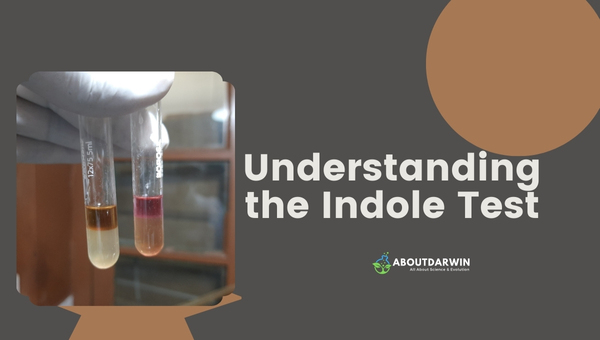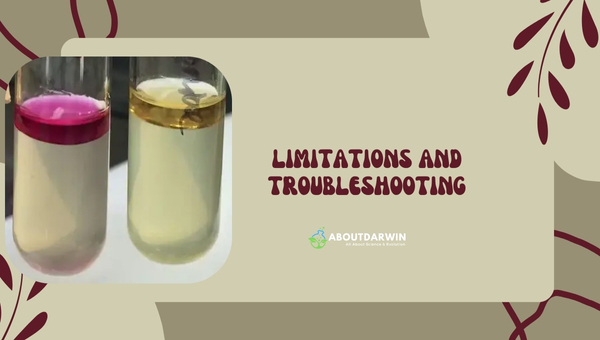Physical Address
304 North Cardinal St.
Dorchester Center, MA 02124
Do you sometimes find yourself puzzled over microbial analyses like the Indole Test? Well, I’m here to simplify it for you. This engaging read unravels the principle, reagents, procedure, result interpretation, and limitations of the interesting world of the Indole Test.
If we boil down this scientific concept into simple language, we’ll see that it’s a test administered to detect indolic compounds produced by certain bacteria. We use this test in microbiology to analyze if a bacterium can produce indole by breaking down tryptophan or not.
Contents
Indole test is a crucial biochemical assay used to identify the ability of certain bacteria to produce indole from the amino acid tryptophan, facilitated by the enzyme tryptophanase.

This test is particularly significant in microbiology for differentiating members of the Enterobacteriaceae family, such as distinguishing Escherichia coli from other related species.
The indole test can be performed using various methods, including rapid spot tests and tube tests, and is often part of the IMViC series of tests that help characterize coliform bacteria.
The indole test principle plays a key role in microbiological diagnostics, especially within the IMViC series, which is used to differentiate members of the Enterobacteriaceae family.
This test detects the presence of the enzyme tryptophanase, which is responsible for the breakdown of tryptophan into indole, pyruvate, and ammonia.
The ability to hydrolyze tryptophan is crucial for identifying specific bacterial species, particularly in clinical microbiology.
Principle of the Indole Test:
The indole test principle centers on assessing a bacterium’s ability to produce indole through the enzymatic hydrolysis of tryptophan. This reaction results in the formation of indole, pyruvate, and ammonia.
When reagents such as Kovac’s or Ehrlich’s reagent are added to the test medium, the presence of indole is indicated by a color change to pink or red, signaling the production of indole.
This color shift is a clear indication that the organism has successfully degraded tryptophan, aiding in the identification of bacterial species.
The indole test principle is invaluable in distinguishing Escherichia coli (indole-positive) from other genera like Enterobacter and Klebsiella (indole-negative).
This makes the test essential for routine microbiological diagnostics. Additionally, it helps identify various other bacterial species based on their metabolic activity related to tryptophan degradation.
Limitations: While the indole test principle is widely used, its results can be influenced by the medium in which the test is conducted. For example, media containing dyes might interfere with the color change.
Additionally, some bacterial strains may produce weak reactions, requiring careful interpretation in conjunction with other biochemical tests for precise identification.
I always believed that knowing why something works was just as important as knowing how it works! So think about this: why would anyone use an indole test?
Well, first off – these tests are used extensively in microbiology labs! Why? Detecting indoles from bacterial metabolism helps us identify specific bacterium present within an evolving microbial community.
Specifically in the medical field, when trying to treat infections caused by bacteria (like E.coli), correct species identification is crucial for prescribing appropriate antibacterial therapy available!
Also Read: Planning a Perfect Family Reunion: A Comprehensive Guide
The uses of the indole test are crucial in microbiology, particularly for identifying specific bacteria based on their ability to produce indole from the amino acid tryptophan.
This test relies on key chemical components and reagents to detect indole production, which is a significant metabolic byproduct of bacterial activity.
Tryptophan, an essential amino acid, plays a central role in the uses of the indole test. In certain bacteria, the enzyme tryptophanase breaks down tryptophan, producing indole as a primary by-product.
The presence of indole can be detected by the indole test, which is why tryptophan must be included in the medium. Without tryptophan, the test cannot proceed, as there would be no substrate for bacteria to convert into indole.
In addition to tryptophan, other chemicals are essential to the uses of the indole test, such as Kovac’s and Ehrlich’s reagents:
Together, these reagents make the uses of the indole test effective in microbiological diagnostics, allowing scientists to identify and differentiate bacteria based on their metabolic capabilities.
Also Read: What is My Cousin’s Cousin to Me? Unraveling Family Ties
When it comes to conducting an Indole test, the entire procedure can be essentially condensed into two main stages: preparation and execution.
Each step, while appearing simple on paper, requires meticulous attention to detail and a profound understanding of microbiological nuances.
There’s always a degree of excitement I feel as I prepare for an Indole test – it’s not just about the test itself; it’s about that very satisfying feeling of knowing your efforts can contribute significantly to identifying different microbial species.
So let’s break down how the “Indole Test- Principle, Reagents, Procedure, Result Interpretation, and Limitations” helps us understand what we need in preparation for this test:
Before I move forward, I must mention this valuable point – patience is indeed a virtue when dealing with microbiology tests! Our tasty broth can take anywhere from 24 to 48 hours for optimal bacterial growth at 37 C (98.6 oF).
Hence, patience, precision, and sterilization are crucial points in our preparation stage for performing an Indole Test.
With careful preparations done the right way – it’s time to execute our practical knowledge to conduct the Indole Test procedure itself:
Remember to always wear safety gear like gloves and goggles while performing these steps. It’s not just about getting accurate results; it’s also about ensuring your own safety in the lab setting.
Also Read: Planning a Perfect Family Reunion: A Comprehensive Guide
Just like any other test, even the Indole Test has its fair share of limitations and requires effort to troubleshoot in case of unexpected results or difficulties.

The following points outline some possible limitations that could occur when conducting an Indole test:
Now let’s look at useful troubleshooting recommendations if you encounter some issues when performing this test:
If such pitfalls are encountered during your testing process, here are a few best practices to apply:
As we wrap up our detailed walk-through on “Indole Test – Principle, Reagents, Procedure, Result Interpretation, and Limitations,” I hope this guide somewhat simplified this chemical reaction mystery for you!
As always, remember that no testing procedure comes without complications or learning opportunities. Remember these steps next time you put on your white coat and approach your tufts of bacteria!
Also Read: Uncovering the Best: GenealogyBank vs Newspapers.com
Common errors include improper incubation of the bacteria, incorrect use of reagents, and misinterpretation of the color results.
Yes, errors in conducting the procedure or selection of bacteria can result in false positive or negative results. Inadequate growth or non-indole-producing strains can give false-negative results.
The breakdown of tryptophan by bacteria is a crucial step in protein metabolism and is particularly used as an indicator for bacterial diagnosis and identification.
Bacteria like E.coli are indole-positive, which helps in their identification and differentiation from other similar but indole-negative organisms.
Results from an Indole test can be confirmed by further biochemical testing specific to identify the cultured bacterial strain.
The Indole Test serves as a fundamental tool in microbiology, allowing for the identification of bacteria capable of producing indole through the breakdown of tryptophan.
It sounds like this test is not only essential for diagnosing infections caused by indole-positive bacteria like E. coli but also plays a critical role in guiding appropriate treatment options.
The principles, reagents, and procedures involved in the Indole Test is vital for accurate results and effective microbial analysis. This knowledge ultimately enhances our ability to tackle bacterial infections and improve patient outcomes.